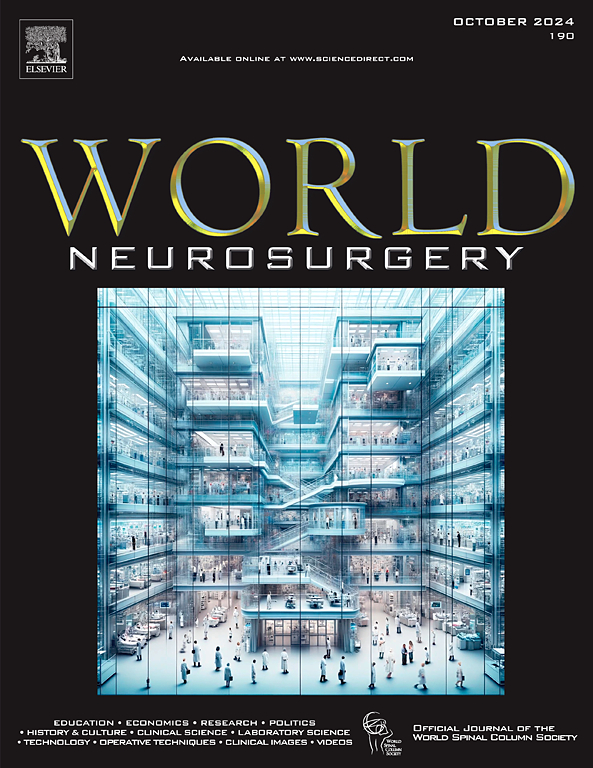放射学压迫程度如何预测马尾综合征?一家国家三级医疗中心的回顾性研究
IF 1.9
4区 医学
Q3 CLINICAL NEUROLOGY
引用次数: 0
摘要
目的马尾综合征(CES)可通过临床和放射学诊断。然而,目前还不清楚影像学上特定程度的马尾受压(CEC)能否确诊。本研究旨在确定核磁共振成像上与 CEC 相关的脱垂与椎管比率(PCR)的最佳百分比,从而有助于对 CES 症状做出可靠的决策。方法在 2020 年至 2021 年期间进行了一项单中心回顾性病例系列分析。61名患者在发病48小时内接受了急诊腰椎间盘切除术,分为CES组和椎间盘脱出(DP)组。CES病例使用ICD-10代码G83.4进行鉴定。PCR 的计算方法是,使用 Windows 上的 IC Measure 软件,将椎间盘突出的宽度除以椎间盘突出水平的椎管总宽度。CES 病例的 PCR 中位数为 76.19% (66.67 - 85.71),明显高于 DP 病例的 48.08% (31.33 - 55.56)(P<0.001)。PCR 阈值为 40% 时,灵敏度最高可达 100%,但特异性仅为 45%。相反,75% 的阈值可使特异性达到 100%,灵敏度为 50%。根据尤登指数确定的最佳 PCR 为 66%,灵敏度为 75%,特异性为 97%,曲线下面积 (AUC) 为 0.923。未来的研究应将 PCR 与临床症状和体征相关联,以进行综合评估。本文章由计算机程序翻译,如有差异,请以英文原文为准。
What Degree of Radiological Compression Predicts Cauda Equina Syndrome: A Retrospective Study at a National Tertiary Centre.
OBJECTIVE
Cauda Equina Syndrome (CES) is diagnosed both clinically and radiologically. However, it's unclear if a specific degree of cauda equina compression (CEC) on imaging can confirm the diagnosis. This study aimed to identify an optimal percentage of prolapse to canal ratio (PCR) on MRI that correlates with CEC, facilitating reliable decision-making for CES symptoms.
METHODS
A single-center retrospective case series analysis was conducted from 2020 to 2021. Sixty-one patients who underwent emergency lumbar discectomy within 48 hours of presentation were included, divided into a CES group and a disc prolapse (DP) group. CES cases were identified using ICD-10 code G83.4. PCR was calculated by dividing the width of the disc herniation by the total width of the spinal canal at the level of the herniation on single mid-sagittal T2 MRI scans, using the IC Measure software on Windows.
RESULTS
CES most frequently occurred at the L4/5 level (37/61). The median PCR in CES cases was 76.19% (66.67 - 85.71), significantly higher than in DP cases, 48.08% (31.33 - 55.56) (p<0.001). A PCR threshold of 40% maximized sensitivity at 100% but had a specificity of 45%. Conversely, a threshold of 75% maximized specificity at 100% with a sensitivity of 50%. The optimal PCR, determined by the Youden index, was 66%, yielding a sensitivity of 75% and specificity of 97%, with an area under the curve (AUC) of 0.923.
CONCLUSIONS
Simple radiological measurements of PCR can potentially triage CES patients and guide their management. Future studies should correlate PCR with clinical signs and symptoms for a comprehensive assessment.
求助全文
通过发布文献求助,成功后即可免费获取论文全文。
去求助
来源期刊

World neurosurgery
CLINICAL NEUROLOGY-SURGERY
CiteScore
3.90
自引率
15.00%
发文量
1765
审稿时长
47 days
期刊介绍:
World Neurosurgery has an open access mirror journal World Neurosurgery: X, sharing the same aims and scope, editorial team, submission system and rigorous peer review.
The journal''s mission is to:
-To provide a first-class international forum and a 2-way conduit for dialogue that is relevant to neurosurgeons and providers who care for neurosurgery patients. The categories of the exchanged information include clinical and basic science, as well as global information that provide social, political, educational, economic, cultural or societal insights and knowledge that are of significance and relevance to worldwide neurosurgery patient care.
-To act as a primary intellectual catalyst for the stimulation of creativity, the creation of new knowledge, and the enhancement of quality neurosurgical care worldwide.
-To provide a forum for communication that enriches the lives of all neurosurgeons and their colleagues; and, in so doing, enriches the lives of their patients.
Topics to be addressed in World Neurosurgery include: EDUCATION, ECONOMICS, RESEARCH, POLITICS, HISTORY, CULTURE, CLINICAL SCIENCE, LABORATORY SCIENCE, TECHNOLOGY, OPERATIVE TECHNIQUES, CLINICAL IMAGES, VIDEOS
 求助内容:
求助内容: 应助结果提醒方式:
应助结果提醒方式:


